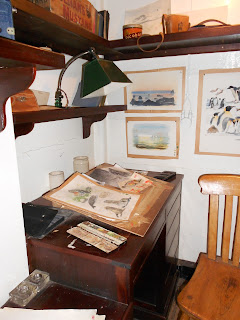The RRS Discovery was the last wooden, 3 masted ship built in Britain, and was designed for expeditions in very cold climates. Her first big trip was the successful 1901 research expedition taking Scott and Shackleton to Antarctica, where she spent 2 years locked in sea ice while her crew mapped parts of the Antarctic coast, travelled by sledge the furthest south that anybody had yet been, relocated the southern magnetic pole, discovered that the Antarctic was indeed a continent and made countless other geological, geographical and biological discoveries.
She was also used as a cargo vessel by the Hudson Bay company, as the HQ for a Sea Scout Group, as a research vessel in the Antarctic again, as a rescue boat for Shackleton's later Antarctic mission (they were rescued before she got there) and again by the Scouts as a training boat in London. In 1986 she went home to Dundee where she was built, and was moved to a custom dock where she is the centre-piece of the Discovery Point museum and visitor attraction.
 The museum is very well put together, with lots of information, exhibits and hands-on interactive things to do for younger ones. After looking at the exhibits you go through to the ship itself. She's beautiful and you really get a sense of scale - just how many bits go into making a sailing ship (with auxiliary engine), and how difficult it must have been to maintain in freezing conditions. Also, what conditions on board must have been like, very close quarters without much heat for two years in atrocious weather, Edwardian fine dining for the officers, preserved food, the amount of supplies they would have needed to carry for a two to three year expedition and how cramped it must have been. And what on earth it must have been like up in the rigging in the South Seas on a stormy day! They've tried to restore the interior to what it would have been like on later expeditions in the 1920s.
The museum is very well put together, with lots of information, exhibits and hands-on interactive things to do for younger ones. After looking at the exhibits you go through to the ship itself. She's beautiful and you really get a sense of scale - just how many bits go into making a sailing ship (with auxiliary engine), and how difficult it must have been to maintain in freezing conditions. Also, what conditions on board must have been like, very close quarters without much heat for two years in atrocious weather, Edwardian fine dining for the officers, preserved food, the amount of supplies they would have needed to carry for a two to three year expedition and how cramped it must have been. And what on earth it must have been like up in the rigging in the South Seas on a stormy day! They've tried to restore the interior to what it would have been like on later expeditions in the 1920s.C. was beside himself with excitement. On arrival there was no way we were going straight to the cafe. Instead we took a short-cut to the ship and had a good explore. Once he'd had his fill we went to the very decent cafe (lovely soup, sandwiches etc.) for a spot of lunch. Then we went through all the exhibits and displays in the museum ("lets go into this bit now", "we'd better go and see what's in this room"), before going back out to the ship once more.
Well worth the £8 per head (under 5's free) entrance fee, which allows you to visit as many times as you like in the following year! I would definitely recommend a visit here if you're in this part of Scotland.




No comments:
Post a Comment